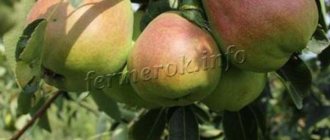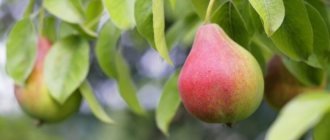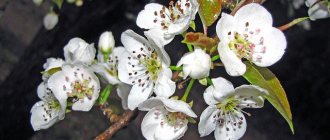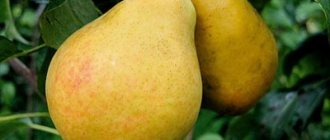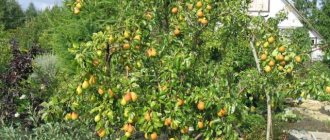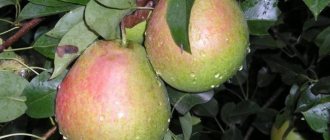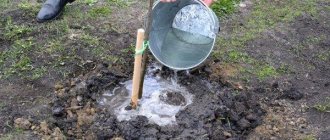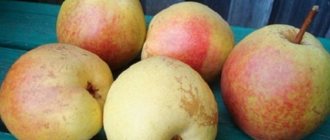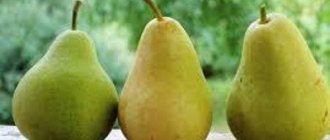The variety “Beauty Chernenko” also has a second name; it is often called “Russian Beauty”. In both versions, the main difference of the plant is noted - the beauty of the fruits. The taste of pears matches their visual appeal. Let's find out what are the features of growing this heat-loving variety, and under what conditions you can get a decent harvest.
Pear variety “Beauty Chernenko”
The fruits of a ripe pear are greenish, sometimes with a slight blush, large, elongated pear-shaped, lumpy
About variety selection
The breeding of this self-fertile variety was carried out by breeders from VNIIGiSPR named after. Michurina. The name “Beauty Chernenko” is given in honor of its creator. The variety has been zoned in the Central region since 1996, but has also become widespread in the North Caucasus, Lower Volga region, Ukraine, Belarus, Transnistria, and Central Asia.
We also recommend reading an article that will tell you about the most popular varieties of pears.
Description and main characteristics of “Beauty Chernenko”
The variety described is an autumn variety. Main characteristics of the plant:
- Tree. Belongs to the vigorous category. Height – up to 5 m. The crown is pyramidal.
- Escape. Sparse, smooth, slightly curved, with slightly pronounced geniculation. There are many small formations on the branches. The branches grow upward.
- Bark. Smooth, without roughness. Brown color.
- Kidneys. Large, brown, cone-shaped, pressed against the shoots.
- Leaves. Wide, dark green, slightly concave. The base is wedge-shaped. The edges are finely jagged. Petioles are of medium length and thickness, without pubescence.
The variety blooms in late May-early June. Bud formation on different parts of the tree occurs at different times. The first flowers bloom on the ringlets - these are short fruiting branches, then the adventitious branches (spears) bloom, and the last to bloom are the annual shoots. The timing of flowering depends on the climatic characteristics of the region. Harvest - in early autumn or late August.
To form the correct crown, during the first five years of life, the branches are bent from the trunk at an angle of 50 degrees.
Description of the Talgar Beauty pear variety
The Talgar beauty pear variety has been known for a long time. It was bred more than half a century ago at the Kazakh Research Institute of Horticulture and Viticulture based on the Forest Beauty variety. The varieties Conference, Goverla and Lyubimitsa Klappa served as pollinators in the selection process. The variety is intended for warm regions, mainly grown in the Krasnodar and Stavropol territories, as well as in Ukraine. In the conditions of the Lower Volga region it grows normally, but in the Middle Volga the cultivation of the Talgar beauty is already causing some problems. To the north of the Moscow region, growing this pear is considered impossible. People often call the Talgar beauty by the affectionate word “Talgarochka”.
The tree of this pear is of medium size, rarely exceeding three meters in height. The pyramidal crown is quite dense, since the main branches are directed almost horizontally, the shoots are almost straight, their diameter is medium, and the color is gray-brown. The leaves are of normal green color, shiny, oval, located on long petioles. A fruit-bearing tree appears squat, since the branches with fruits descend strongly to the ground. The tree is drought-resistant, reacts normally to frost, can withstand temperatures down to -30 °C, and slight frosts heal over time. The variety is considered unpretentious in care.
The Talgarka tree does not look very neat, since the branches bend to the ground under the weight of the fruits
Cone-shaped buds are large. The ringlets serve as fruit-bearing formations. The variety is characterized by early fruiting: the first harvest is produced in the fourth year after planting, but for the first 1–2 years it is small. Productivity is subsequently high, annual, and gradually increases with age. The fruits ripen late: no earlier than the end of September.
The fruits are very beautiful, large (weighing 160–200 g), elongated “bottle” shape. The skin is smooth, dense, the main color is pale yellow, but largely covered with a bright red blush, there are numerous subcutaneous spots. The pulp is dense, white or slightly creamy, juicy, crispy, the taste is rated as good, sweet, and improves with storage. Slightly unripe fruits are stored in the cellar for about two months, sometimes much longer. Ripe pears hold tightly to the tree and do not fall off in the wind, which is not always good: overripe pears are not suitable for consumption. The transportability of fruits picked unripe is good.
It happens that the fruits of the Talgar beauty hang in clusters on the tree for a long time
Thus, the main advantages of the variety are:
- ease of cultivation;
- drought and frost resistance;
- resistance to many diseases;
- high productivity;
- attractive appearance of the fruits, their size;
- good taste;
- good shelf life and transportability.
Disadvantages include the rough texture of the fruit and the fact that pears that are not picked in time spoil on the tree.
Main types of pollinators
Unfortunately, the Talgar beauty is not self-fertile, and in the absence of pollinators, its harvest is insignificant. For normal yields, cross-pollination is necessary, that is, the presence of certain varieties of pear trees nearby. The best pollinators are considered to be those varieties that took part in the creation of Talgarochka: Goverla or Conference. Kucheryanka also pollinates it quite well.
Naturally, a whole tree of another variety is not needed for pollination; the necessary varieties can be grafted into the crown of the Talgar beauty.
But, firstly, it must be more than one branch, and secondly, until the grafts grow, you will have to make do with a very meager harvest. Along the way, we can say that grafting is often used to have several branches of the Talgar beauty itself on the site: if you graft it onto a forest pear, winter hardiness will increase significantly. In addition, the variety grows well with quince, which is also often used in practice.
Pear fruits and fruiting
Fruit characteristics:
- taste - sour-sweet, with a light aroma;
- shape - elongated, pear-shaped, with tuberosity present;
- peel – medium thickness, there is a slight waxy coating;
- the pulp is white, slightly oily, dense and juicy;
- color - when ripe, the fruits are greenish, with slight redness; when ripe, they become greenish-yellow with a red-brown blush;
- seeds are elongated, brown.
The fruits contain:
- sugar – 9.8%;
- vitamin C – 5.7 mg per 100 g;
The variety maintains active fruiting for 30 years. And the lifespan of a tree is about 50 years. Life expectancy and ability to bear fruit depend on agricultural technology. The average yield per tree is 120-140 kg per year. Can reach 200 kg per tree.
Description of the fruit
The pear got its name from the taste and appearance of the fruit. Its shape is elongated pear-shaped, graceful, with tubercles visible under the skin. The stalks are long, also slightly curved. They are held very firmly, so the fruits are not prone to shedding. The peel is medium thick, covered with a waxy coating.
At the time of harvest, the pear remains green in color with a slight pink blush. When market ripeness is reached, the fruit becomes golden-green with a blurred red blush.
Thanks to the dense skin, the pear retains its presentation during transportation and is stored longer than summer varieties - up to 2 months. However, long-term protection of fruits is impossible.
- Calorie content is 43 kcal/100 g. The fruits are excellent for dietary nutrition.
- The taste of a ripe pear is wonderful: very juicy, full, sweet, with a gentle sourness. The flesh is semi-oily, tender, very light cream in color; when cut, the flesh is slightly matte. However, the taste of the fruit depends on the ripening conditions. So, during drought and lack of watering, the skin of the fruit begins to taste bitter.
- The size of the fruit allows pears to be classified as large: by the time of maturity they gain 200–250 g. Larger specimens are also found.
Fruits are picked unripe for sale. To eat fresh, you should wait until they are completely ripe. Pears are also used in cooking: excellent summer salads are prepared from the fruits, added to yoghurts and ice cream. In addition, jams, preserves, and compotes are made from pears.
Advantages and disadvantages
“Beauty” combines the excellent taste of the fruit with demanding growing conditions. Table 1 shows the pros and cons of the variety that gardeners should pay attention to.
Table 1
| Advantages | Flaws |
| Self-fertility | high tree height |
| High quality fruits | heterogeneity of fruits |
| Not affected by scab | late fruiting |
| Resistance to fungal diseases | low frost resistance |
| Large fruit | low drought resistance |
| Strong young shoots | the crown is prone to elongation |
| High yield | tendency to overload |
| Long fruiting period | affected by powdery mildew and brown spot |
The main factor forcing gardeners to plant “Russian Beauty” is its excellent-tasting fruits and high yield. But before making a choice in favor of this variety, you should assess the risks - the fruiting of the “beauty” depends too much on climatic conditions. In addition to low frost resistance, gardeners are frightened by the prospect of a long wait - the first fruits can be obtained only after 6-8 years of life. We have to wait another 3-4 years for good harvests.
You can find out what advantages the “Russian Beauty” pear variety has in the video below:
Features of care
This variety is not capricious and requires fairly simple care. The basics of caring for this variety include the following procedures:
- Watering.
- Feeding.
- Crown formation.
- Protection from pests and diseases.
Let's talk in more detail about each procedure.
Watering
As for irrigation, in the summer, during peak heat, the tree is watered once a week with 3-4 buckets of water. During the entire season, the tree needs to be watered at least 4 times:
- Before flowering begins.
- After the formation of the ovaries.
- During the dry season.
- In autumn, after harvest.
Fertilizer
As for fertilizing, in the first two years the tree does not need fertilizers, since they were applied to the planting holes. In subsequent years, the frequency of fertilizing the tree depends on the area in which it grows. For example, when growing a pear on sandy soils, the tree needs to be fertilized every year. If it is grown on chernozem or clay soil, then the tree needs fertilizers every 2-3 years.
We also recommend reading: Description of the Talgar beauty pear variety
As for the feeding scheme, it is as follows:
- In spring, the tree is fertilized with humus. Consumption - 2 kg per 1 m2.
- In the fall, fertilize the pear with mineral fertilizers. For 1 m2, 600 g of ash, 15 g of urea, 20 g of nitrate and 50 g of superphosphate are consumed.
Crown formation
Inexperienced gardeners often neglect pruning a tree for two reasons: they are afraid of injuring it or simply do not know about the benefits of this procedure. In fact, pruning plays a vital role in caring for the Forest Beauty pear.
The formation of the crown helps not only regulate the growth of the tree, but also protect it from the occurrence of diseases.
The tree does not need to be touched for the first year. In the second year they begin pruning. Shorten the main shoot by approximately 1/3 of its length. In the fall, remove damaged and diseased branches, which can worsen the wintering of the tree. Also, it is worth removing branches that thicken the crown too much.
Diseases
The main diseases faced by this variety are powdery mildew and rust. To prevent the tree from encountering this infection, it is necessary to carry out preventive treatments. They are carried out in the spring by spraying the trees with copper oxychloride - a 0.5% solution. Treatments are carried out before buds open and after flowering.
If a tree encounters scab, then in the fall the tree is treated with a 1% solution of Bordeaux mixture.
Landing location
Weak frost resistance does not allow the “beauty” to grow in areas with a harsh climate. The variety does not feel comfortable in most regions of the country. The range is limited to the north of the Moscow region. In the southern regions, the pear also does not feel well; due to droughts, the taste characteristics of the fruit deteriorate - their skin becomes rough and bitter.
“Beauty Chernenko” is zoned in the regions:
- Central;
- Central Black Earth.
For a safe winter in central Russia, the tree is insulated.
Select areas for planting:
- well lit, sunny;
- protected from wind and drafts;
- without unevenness - so that rainwater does not stagnate;
- located on the south, southwest or southeast side;
- unshaded - the distance to the nearest planting should be at least 4-5 m;
- Preference is given to light and loose soils; clay content in the soil is encouraged - it promotes water retention.
By the plants growing in the area, you can determine whether it is suitable for a pear or not. “Beauty Chernenko” is not recommended to be planted in the area where it grows:
- Plantain, mint, horsetail, buttercups, heather. They indicate increased soil acidity. The best soils for pears are slightly acidic. To reduce acidity, lime is added to the soil. The amount of lime added to the soil is determined by the degree of acidity of the soil.
- Horsetail and sedge. They indicate the proximity of groundwater - this option is undesirable for a pear. Trees are not recommended to be planted near buildings, fences, or other structures that can cast a shadow.
- Juniper. This plant is a source and carrier of many diseases dangerous to pears.
The time for planting seedlings depends on climatic conditions:
- in regions with a temperate climate - late April or early May;
- in the southern regions - late September or early October.
Only in areas with eclimatic conditions does the plant have time to strengthen before the cold weather and survive the winter.
Features of planting and preparation for it
It is recommended to select one- or two-year-old seedlings with intact active buds and an intact root system for planting. As for the optimal time, both spring and autumn are suitable. In regions with a temperate climate, it is better to plant in mid-April or early May, so that the tree has time to get stronger before the winter cold. In the southern regions, the best time is September or the first half of October. The seedling will have time to take root well before frost, and in the spring it will quickly grow.
The pear tree prefers warm, dry, well-lit and sheltered places from the winds. This is what they are guided by when choosing a site for cultivation. Do not plant a pear where sedge or horsetail grows - this is an indicator that groundwater comes very close to the surface, and it does not like dampness. The looser and more nutritious the soil on the site, the better, although in general the Russian beauty is not very demanding on the substrate.
You should not plant the pear tree too close to fences or buildings, as it does not like the shadow. Try to maintain a distance of about 5–6 m from any obstacle blocking the sun. Avoid proximity to juniper - it, without becoming infected, is the main carrier of the so-called rust, which is easily transmitted to the fruit tree.
It is advisable to place pollinators next to the Russian Beauty tree, for example, Yakovlev's Lyubimitsa, Moskvichka, Lada Amurskaya.
Dig the planting hole in the fall; the dimensions should correspond to the size of the root system with a margin for its development. The approximate width is 75–80 cm, depth is 80–100 cm. If groundwater lies close to the surface, then the second parameter is reduced to 30–40 cm.
The further development of the tree depends on the correct planting
The bottom of the hole should be slightly loosened with a pitchfork or shovel. To improve the quality of heavy soil, pour a couple of buckets of sand into it. If the soil, on the contrary, is acidic, pour in a solution of fluff lime (2 cups per bucket of water). In addition, add 2.5–3 buckets of compost or humus mixed with topsoil, a glass of superphosphate and three tablespoons of potassium sulfate.
Procedure for planting a pear tree:
- Drive a support for a seedling about 1.5 m high into the mound at the bottom of the planting hole.
- Place the tree so that the root collar is level with the surface of the earth or slightly higher, and spread the roots over the earthen mound.
- Fill the hole with soil, periodically shaking the seedling slightly.
- Compact the soil around the tree with your foot pointed towards the trunk (careful not to damage the roots).
- Tie the plant to a stake (not tightly) and water it with two or three buckets of water.
- When the moisture is absorbed, mulch the tree trunk circle (peat, sawdust with a layer 2–3 cm thick).
Video: how to plant a fruit tree correctly
Preparing for the landing of the "Russian Beauty"
What to do before disembarking:
- Trim the largest roots by 10 cm.
- Cut off the top. After trimming the roots and top, the seedling becomes like an ordinary stick. Its length is approximately 70 cm.
- The roots are placed in a bucket of warm water. Stand for 1 hour.
- Prepare the mixture by mixing the soil extracted when digging a hole with ash (1:1). Add water - enough so that the mixture acquires a creamy consistency. The roots are soaked in it. Now the tree is ready for planting.
Landing technology
Procedure for planting pear seedlings:
- A bucket of water with 2 tbsp is poured into the hole. l. dolomite flour. Then two more buckets of water are poured in.
- A tubercle is made in the pit from:
- land;
- turf;
- manure - 2-3 buckets;
- potassium sulfate – 3 tbsp. l;
- superphosphate – 250 g.
- A peg 1.5 m high is placed in the tubercle - at a distance of 3-5 cm from the center. It should stand on the south side of the seedling - to serve not only as a support, but also as protection from the sun.
- The tree is placed so that there is 3-5 cm between the neck and the ground.
- The roots of the seedling, evenly distributed over the mound, are covered with earth.
- A ditch is dug around the hole, up to 8 cm deep, and watered. For one seedling - 20 liters of water.
- The tree is tied to a peg using some elastic material. You cannot tie a seedling with wire - you can damage the tree.
- Finally, the soil around the tree trunk is sprinkled with mulch.
How to plant a pear
Russian beauty is a self-fertile variety and does not require additional pollination. But, according to the observations of gardeners, a tree bears fruit best if Lada Amurskaya, Moskvichka or Lyubimitsa Yakovleva pears grow nearby. These varieties bloom and bear fruit at approximately the same time, which allows them to cross-pollinate each other.
In the presence of pollinators, the Russian Beauty tree produces maximum yield
A place for a young pear should be chosen that is sunny, well-lit, protected from the wind, at least 4 m away from walls and high fences and at least 3–3.5 m away from other trees on the site. When growing close together, the plants shade each other , and also transmit various diseases. The groundwater level in the area should be no higher than 2 m for the pear to feel comfortable. Otherwise, before planting, build an artificial embankment 50–70 cm high for the seedling, and carefully drain the bottom of the planting hole with large pebbles (a layer of at least 5 cm). The soil for pears should be neutral acidity (pH 5.7–6).
The pear tree needs a sunny place protected from the wind.
It is best to plant an annual or biennial tree. The tree should look healthy, have a flexible trunk and branches, smooth bark, a developed root system without rotten or dried branches from at least 3 main shoots.
The plant can be planted both in the fall (in October) and in the spring (in April), when the soil warms up sufficiently. The night temperature should be at least 3–5°C for 5–7 days in a row. The planting hole for a young tree should be prepared in the fall at least 10 days before planting. To do this you need:
- Dig a hole with a diameter of 80 cm and a depth of 80–100 cm.
- Mix the top layer of soil (20 cm) with 20 kg of ready-made organic fertilizer (compost, humus), 1 kg of wood ash, 100 g of potassium sulfate and 350 g of superphosphate.
- Place the resulting mixture in a heap at the bottom of the hole.
- Cover the top of the hole with a thick film so that moisture does not penetrate into it.
The hole should be deep enough to accommodate the roots freely
Before planting, you need to prepare the tree itself:
- The strongest roots of the seedling are cut off by 10–12 cm, and the top is completely cut off. Thus, the tree becomes just a straight stick without branches, 70 cm high.
- The roots of the seedling are placed in a bucket of warm water for 1 hour.
- Prepare a “matter”: soil dug out of a hole is mixed with ash in equal proportions and diluted with water to a creamy consistency. The roots are dipped into this mixture.
Planting a pear should be done as follows:
- In the hole, install a support stake with a height of about 120–150 cm at a distance of 3–5 cm from the center.
- If necessary, adjust the soil at the bottom of the hole so that it is formed in the form of a mound.
- Place the seedling in the center of the mound so that the root collar of the plant is 5–7 cm above the ground.
- Distribute the pear roots.
- Tamping layer by layer, fill the hole with earth.
- Build a ditch 6–7 cm deep along the edge of the hole and water the tree with 20 liters of water.
- Tie the seedling to the support stake with elastic material, without using wire, as it can damage the tree.
- Mulch the tree trunk with sawdust or peat.
Mulching retains moisture in the soil for a long time
Video: how to plant a pear correctly
Tree care
The variety is considered undemanding to care, but for a decent return - 50-60 kg of pears from one tree, a set of agrotechnical measures is required.
Watering and whitewashing
Pears do not tolerate excessive moisture. Excess moisture often causes root rot. At the same time, “Russian Beauty” does not like drought - it is watered several times a season, 30-40 liters at a time. The portion is divided into 2 parts - one for the morning, the second for the evening.
Watering order:
- The tree is watered for the first time in the spring, before flowering.
- The second time is after the tree has finished blooming. This watering determines how strong and healthy the ovaries will be.
- During the summer, the tree is watered 2-4 more times - as needed. The soil under the tree should become wet 50-60 cm deep.
- The last time the pear tree is watered is in the fall.
The irrigation regime and water rates depend on the age of the tree:
- 1st year. Young trees require frequent moisture. They are watered weekly - 10-15 liters.
- 2-5th year. Water once every 2-3 weeks with 20-25 liters.
The watered soil is loosened a little later and mulch is sprinkled to retain moisture. The recommended method of moisturizing is sprinkling.
Whitewashing is carried out twice a year - in autumn and spring. The purpose of the event is to protect the tree from mice, insects, frost and thermal burns. The trunk and branches of the first tier are treated with a compound that protects it from rodents and insects. Ingredients:
- lime – 2 kg;
- powder clay – 1 kg;
- copper sulfate – 300 g;
- water - 7 liters for mature trees and 12 liters for young trees.
Top dressing
After planting the seedling, fertilizing is not carried out. Regular application of fertilizers begins in the second year. The tree is fed twice a year - in spring and autumn. Organics are added once every three years, minerals – annually. Table 2 shows the methods and timing of feeding pears.
table 2
| Substance | Deadlines | How to deposit? |
| saltpeter | flowering period | Under the root. Dry matter – 30 g/sq.m. m, in the form of a solution – 1:50. |
| urea | bloom | Under the root. For 5 liters of water take 80-120 g. |
| nitroammophoska | May | Under the root - 150 g per 30 l. For a tree - 3 buckets of solution. |
| urea | end of September | For the root – 600 g per 10 liters of water. |
| mineral fertilizers | beginning of autumn | Under the root - potassium chloride (1 tbsp.) and granulated superphosphate (2 tbsp.) - per 10 liters of water. Over time, the proportions of substances increase. |
Trimming
“Beauty Chernenko” belongs to the vigorous group. The tree needs regular pruning.
The first pruning is carried out in the second year of the tree's life. The time for pruning is spring, before the buds open. How to prune:
- 1st year. All shoots are trimmed, leaving only 3-4 strong shoots - they are reduced by 30%. The main conductor is cut by 20-25 cm.
- 2nd year. The procedure is repeated, forming the 2nd tier of the crown from two or three branches - they are cut off by 20-25%. The remaining shoots are cut out.
- 4th year. Create a third tier of 1-2 shoots. The main conductor is pruned again to prevent the tree from growing too tall. Excessive growth often prevents the tree from developing properly. The distance between adjacent tiers is 40-60 cm.
- 5th year. The crown is thinned to prevent thickening and lighten the crown.
- 8-10th year. Anti-aging pruning - trim the ends of the branches by 30%, and cut the main conductor - by 40%. The tree becomes smaller, better able to withstand winds, and easier to care for.
To stop the growth of a tree and thin out the crown, you can remove its entire upper part.
In order to extend the period of fruiting, the branches of the tree are bent, starting from 2 years. As a rule, there is an acute angle between the shoots and the trunk; it is difficult for such branches to bear fruit. The gardener, bending the branches to 60-70 degrees, facilitates the fruiting process.
To bend branches, use one of two methods:
- tie down weights that pull back the branches;
- tied to a rope, which is secured to stakes driven into the ground.
In the fall, at the end of October, sanitary pruning is carried out. The plant needs 2-3 weeks before frost to regain its strength. When pruning, branches are removed:
- dry;
- deformed;
- damaged.
All cut branches are burned. For pruning, use a disinfected tool. The wounds are covered with varnish. Instead of garden varnish, you can use paint.
Preparing for winter
The variety tolerates frost down to minus 25 °C, so you can’t do without insulation:
- Leaves, weeds, branches, and other debris are removed from under the tree.
- To destroy insects, dig up the soil near the tree.
- Mulch the soil (sawdust/peat) - 15-20 cm. With the arrival of spring, the mulch is raked away.
- Paint the trunk and thick branches with lime mortar.
- To insulate the trunk, use spruce spruce branches or burlap. To secure the insulation, use a mixture of clay and manure (1:1).
- Snow is shaken off the branches to prevent them from breaking. There should be a snow cushion 40-50 cm thick under the tree.
Aftercare
The further growth and future yield of the Russian Beauty variety depends on how the seedling care plan is constructed:
- Watering. The Russian beauty does not tolerate drought, but also does not like waterlogging. In spring, pear trees are watered twice: before flowering and after flowering begins. In summer, depending on the prevailing air temperature, the tree is watered 2 to 4 times. In autumn, pre-winter watering is carried out, which is the only source of moisture for the entire coming winter.
- Feeding. The pear needs regular feeding. In the autumn, trees are fertilized with organic matter, and in the spring they are fed with ammonium nitrate to grow foliage. In the summer, the pear is supported by adding superphosphate to promote the formation and ripening of the fruit.
- Trimming. The Russian Beauty variety requires additional regular pruning. In the spring, the crown is thinned out in layers. At each level, 4 strong young shoots are left. In the summer, the resulting shoots are pinched, which interfere with growth. Autumn pruning involves branches that grow inside the crown.
- Preparing for winter. The Russian Beauty pear is prepared for winter in stages. First, the tree trunk circle is dug up, covered with a new layer of mulch, then whitewashing begins. The trunk and lower branches are whitened with slaked lime. Then the base of the tree is covered with spruce branches or wrapped in burlap. Additionally, protective nets are installed around the trunk against rodents.
Advice! In winter, snow is shaken off the branches so that they do not break under its weight.
Diseases and pests
The variety is resistant to scab and fruit rot. But pests and diseases can significantly reduce yields. What problems are possible and how to counter them are in Table 3.
Table 3
| Diseases and pests | Diagnostics | Treatment and prevention |
| Pear sucker | A sticky gray coating appears on buds, buds, and shoots | At the stage of bud formation, the tree is treated with Fufanon. In the fall, the leaves are removed and the soil is dug up. |
| codling moth | The pears fall off before they are ripe, with larvae inside them. | Treat the tree before flowering and after flowering with Iskra-M. 3-4 weeks before harvesting - Iskra-D. The soil is carefully dug up in the fall and fallen fruits are collected. |
| Brown spot | Brownish spots appear on the foliage | Before flowering, the tree is treated with 3% Bordeaux mixture. For prevention, carefully dig up the soil. |
| Powdery mildew | A whitish coating appears on young leaves, ovaries and shoots, darkening over time | The tree is treated with Baktofit 4 times per season, taking breaks of 10-14 days. Before flowering, spray with Kuprosil. After flowering - 2 times per summer with breaks of two weeks. |
| Black cancer | Cracks appear on the branches and trunk | Damaged areas are removed using a metal brush. Treat with copper sulfate 2% and cover with garden pitch. |
Description of the Russian Beauty variety and photo of the fruits
Pear Russian Beauty was bred for central Russia. This variety does not tolerate harsh winters well, so even mature trees feel uncomfortable in the north of the Moscow region. You should not plant pears in the southern regions either, since dry summers and lack of watering can spoil the taste of the fruit: the pear skin will become rough and bitter.
The fruits of the Russian beauty ripen together
The Russian Beauty tree is tall, 5–6 m in height. This sometimes makes it difficult to care for and harvest pears. The crown is pyramid-shaped, sparse. The leaves are large, dark green, sharply pointed towards the tip. The trunk and branches of the tree are brown, smooth, even, growing upward. The pear blossoms in mid-May and bears the harvest in early September. Thus, Russian Beauty is an early autumn variety.
Sometimes Russian beauty pears reach 300 g
Russian beauty begins to bear fruit 6–7 years after planting and reaches full yield in 3–4 years. About 60 kg of fruit can be removed from an adult tree. Weight of pears - from 160 to 300 g. The pulp of the Russian beauty is juicy, aromatic, slightly oily, sweet in taste with a slight sourness.
Table: advantages and disadvantages
| pros | Minuses |
| Delicious and beautiful fruits | Low frost resistance (afraid of frosts below -25°C) |
| Self-fertility | Hard to tolerate drought |
| Is immune to scab and fruit rot | Late onset of fruiting |
| Large tree size |
Collection and storage of pears
“Beauty Chernenko” is a table variety, so its fruits are best consumed fresh. Although the fruits ripen in September, you can start picking a little earlier, at the end of August - while the pears are yellow and have not acquired their characteristic blush. Fruits taken from the tree a little under-ripe store better.
Pears are harvested only in dry weather. When harvesting, it is important not to break the stalks - then the fruits will be stored for a long time, about two months. For storage, pears are placed in the cellar or refrigerator. The fruits must not be damaged. The optimal temperature for storage is 1-3 °C.
The fruits of “Beauty Chernenko” are suitable for preparations; they are used to make preserves, marmalade, compotes, marshmallows and candied fruits. Only dense, slightly unripe pears are allowed into processing - then they will retain their sweetness and elasticity. The variety is not suitable for drying.
Collection, storage and use of crops
Russian Beauty pears ripen in late August - early September. Yellowing of the skin indicates complete ripeness.
The fruits must be removed carefully so as not to damage them. Collection begins from the outer part of the crown and moves to the center. Then they move from bottom to top. The pear is tightly clasped with your fingers and gently bent upward until the stalk is separated from the branch. You can't pull it on yourself. Try not to drop fruit: falling even from a small height inevitably causes mechanical damage.
The harvested fruits are carefully placed in a suitable container and placed in the shade. Sort the harvested crop immediately: for long-term storage, leave only absolutely healthy pears with smooth skin, without the slightest traces of disease and pest damage and with an intact stalk.
You can make marshmallows from pears with your own hands - an excellent and well-preserved delicacy
To preserve fruits for a long time (as long as possible), place them in wooden boxes or wicker baskets, sprinkling layers with dry sawdust (you can use paper or soft hay). In a cool room at a temperature of 1–3ºС, the crop can be stored for 1.5–2 months.
Damaged and wormy pears can be eaten fresh (as a table variety should be) or prepared for the winter in the form of jam, jams, juices, compotes and even marshmallows.
Reviews about the variety
★★★★★
Korneev Zh.Yu., 66 years old, Kaluga region. The variety reminded me of Yakovlev's Memory, but Beauty has a simpler taste.
But its fruits are very large. The disadvantage of the variety is its weak ability to shoot. To get the skeleton of a tree, you have to trim the branches all the time, but they all point up. The only way out is to bend the branches to the ground. Another drawback is poor frost resistance. If frost strikes and you haven’t bothered to insulate the tree, it could easily die. But it happens, and insulation does not help; my pear tree died in the 11th year of its life. I am inclined to think that it is better to plant this variety not as a seedling, but to graft it onto a more frost-resistant rootstock.
★★★★★
Verevkin O.L., Dedovsk. “Beauty Chernenko” has excellent fruits - the taste is wonderful.
After trying it, I decided to plant it on my site. The tree has been bearing fruit for four years now. The pears come in different sizes, but there are no complaints about the taste. Before winter you have to carefully insulate it - otherwise it will freeze. I fertilize mainly with organic matter; I only used “chemistry” once, during planting. Hide
Add your review
“Beauty Chernenko” has earned the recognition of gardeners due to the high taste of the fruit. This variety is unpretentious, but requires certain growing conditions. If all agrotechnical requirements are met, the variety successfully bears fruit not only in the southern regions, but also in the middle zone.
0
0
Copy link
Characteristics of the variety
Pear Russian beauty has good characteristics. The harvest can be stored for one and a half months. The Russian Beauty (Chernenko) garden pear variety can be grown for industrial use. Juices and jams are made from the fruits of this tree, and they are also used in winemaking.
Description of the tree
The description shows that the tree is medium-sized, reaching a height of 5 meters. The trunk volume is 2.5 meters. The branches grow upward. The shoots are medium in size and have fluff on them. After planting a seedling, you will have to wait 8 years for fruits. The leaves are small in size and elongated in shape with fine serrations. The leaf color is light green. Flowers that grow with large white petals. Winter time does not frighten this variety, as it is resistant to cold.
Description of fruits
The fruits are very large. The weight of the fruit is on average 150-200 g. Externally, the Krasavitsa Chernenko pear is similar to the fruits of the Lyubimitsa Yakovleva and Moskovskaya northern varieties, but only of an elongated shape. The peel is medium in density and thickness. Color changes with maturity. When ripe, the fruit is green and has a slight blush. During consumer ripeness, the fruit becomes green-yellow in color with a distinct and large blush.
Taste qualities of the variety:
- sweet and sour taste
- juicy, soft, white pulp.
The fruits can be consumed both fresh and processed.
The fruits are large. The weight of the fetus is on average 150-200 g
Let's look at the basic requirements for crop care.
Soil preparation and planting
According to the description, autumn is the best time to plant this variety. Before planting the seedling, you need to prepare high quality soil. The entire area needs to be dug up, in the process removing weeds, remnants of other plants and any debris. Afterwards, you need to prepare the landing hole. It is recommended to fertilize it with mineral fertilizers (two glasses of mineral fertilizer per 1 liter of water). Now you can start planting the seedling. You need to plant so that the upper part of the root looks out from under the ground. When the tree has been planted, almost all the leaves should be trimmed. Afterwards you need to water the soil so that it becomes moist.
Care after landing
Care after planting is the longest stage. The tree requires weekly watering. The amount of water needed for irrigation increases with the growth of the tree. The plant needs to be fertilized. The plant should be fed 3 times a month. It is recommended to use mullein or urea as a fertilizer (25 grams of mullein or urea per 1 liter of water). In early spring, the leaves should be pruned to attract pollinators.
